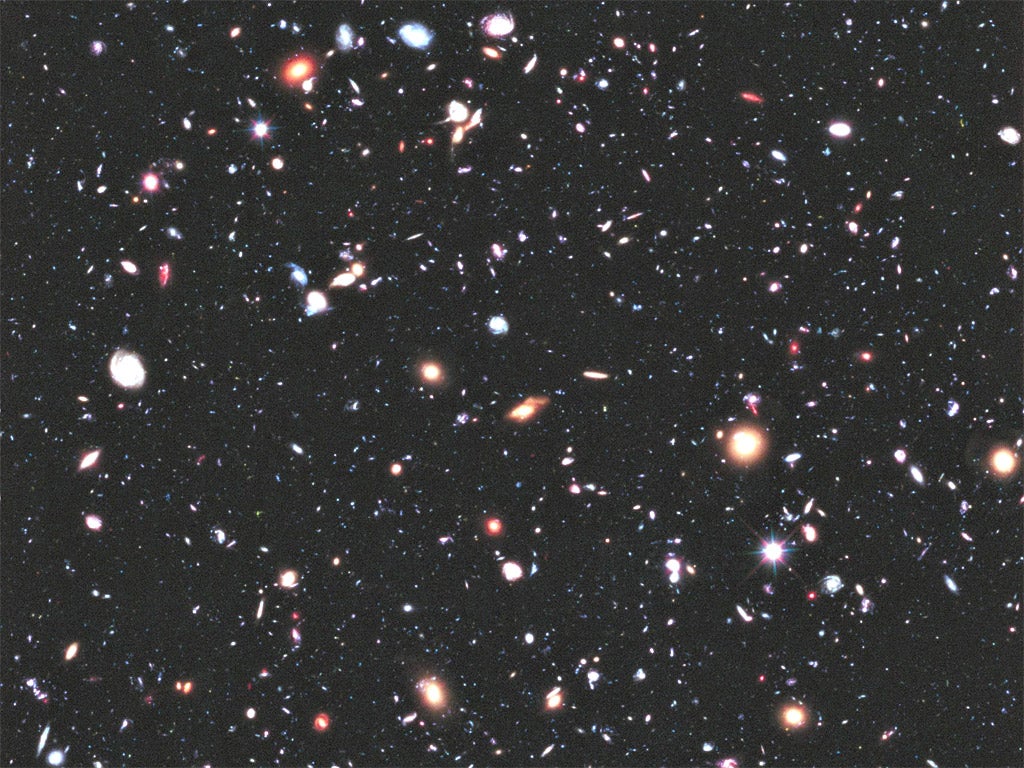A long time ago in galaxies far, far away
A picture of extreme deep space as it was more than 13 billion years ago has been revealed in photographs taken by the Hubble telescope

Of all the images of space, this one is possibly the most enigmatic. It shows a tiny patch of sky, about the size of penny held 75 feet away, stuffed with more than 5,500 galaxies composed of hundreds of millions of stars.
What makes this image so spectacular is that this tiny field of view in the southern sky near the constellation of Fornax seems to be devoid of anything when viewed through telescopes on Earth. It is only when this patch of sky is observed through the powerful Hubble Space Telescope that it becomes so alive with cosmic objects.
And just to add to the enigma: the patch of sky is just one of 30 million that make up the complete cosmic panorama.
Nasa has called this picture the Extreme Deep Field (XDF) to emphasise that it represents stars and galaxies that are further away (hence deeper in space) than anything seen in other regions of the sky. In fact these galaxies are so far away that it has taken up to 13.2 billion years for their light to reach Earth – less than half a billion years after the Big Bang that created the Universe 13.7 billion years ago.
The XDF image, released yesterday, reveals some of the earliest and faintest galaxies, some only about ten billionths of the brightness discernible to the human eye. Most of them, Nasa says, are seen here when they were young, small and growing, often violently as they collided and merged.
This early phase in the life of the Universe was a time of dramatic creation for new galaxies containing brilliant blue stars that were far brighter than our Sun. Some of the objects are spiral galaxies similar to our own Milky Way and nearby Andromeda galaxy. Others are large, fuzzy red galaxies in their declining phase.
Peppered across the field are tiny, faint galaxies that are even further away in both space and time. Nasa says these were like the seedlings from which today's magnificent galaxies grew. "The history of galaxies – from soon after the first galaxies were born to the greatest galaxies today, like our Milky Way – is laid out in this one remarkable image," Nasa says.
The XDF image is in fact a composite picture made from more than 2,000 observations of the same patch of sky over a number of years. An earlier composite, called the Ultra Deep Field, in the visible light spectrum has now been complemented by the addition of infrared detectors added to the Hubble in 2008.
The extra visual firepower has enabled astronomers to peer back in time as well as through the depths of space – a feature of the fact that Hubble is a special kind of "time machine", according to Marc Postman, an astronomer at the Space Telescope Science Institute in Maryland.
"We had a view that galaxies were out there a few billions years back but we didn't know whether they went all the way back to the very earliest epics in the Universe," Dr Postman said.
This changed with the Hubble deep field views, he said. "We saw things that were much further away than any previous observations had shown . We were looking back when the Universe was less than a billion years old."
As Garth Illingworth, professor of astronomy at the University of California Santa Cruz, says: "We could push out to earlier times. We could find even more distant objects than we'd ever been able to do before. We can't see the first galaxies but this has put us on the fringes of that time."
Subscribe to Independent Premium to bookmark this article
Want to bookmark your favourite articles and stories to read or reference later? Start your Independent Premium subscription today.

Join our commenting forum
Join thought-provoking conversations, follow other Independent readers and see their replies